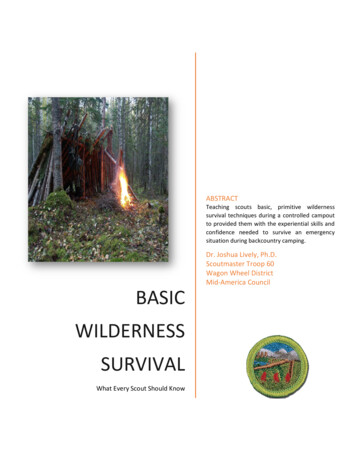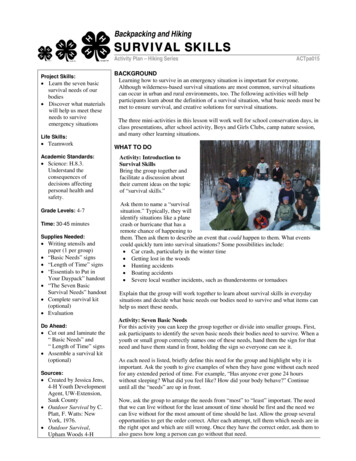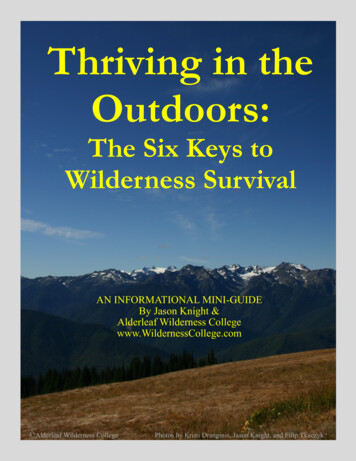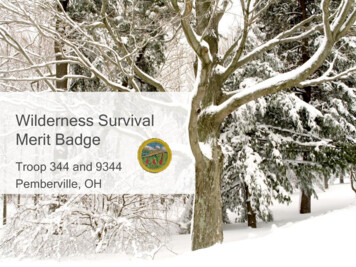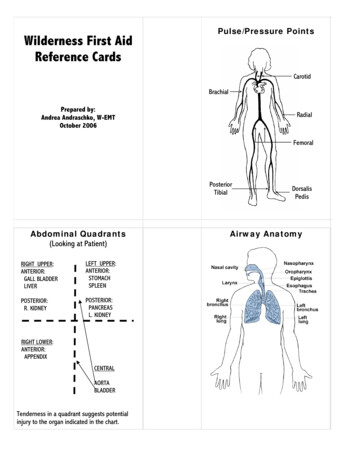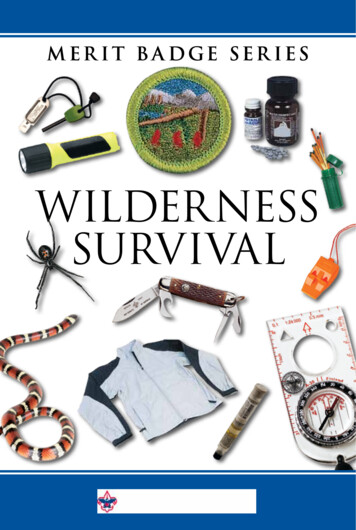
Transcription
wildernesssurvival
How to Use This PamphletThe secret to successfully earning a merit badge is for you to use boththe pamphlet and the suggestions of your counselor.Your counselor can be as important to you as a coach is to an athlete.Use all of the resources your counselor can make available to you.This may be the best chance you will have to learn about this particularsubject. Make it count.If you or your counselor feels that any information in this pamphlet isincorrect, please let us know. Please state your source of information.Merit badge pamphlets are reprinted annually and requirementsupdated regularly. Your suggestions for improvement are welcome.Send comments along with a brief statement about yourself to YouthDevelopment, S209 Boy Scouts of America 1325 West Walnut HillLane P.O. Box 152079 Irving, TX 75015-2079.Who Pays for This Pamphlet?This merit badge pamphlet is one in a series of more than 100 coveringall kinds of hobby and career subjects. It is made available for youto buy as a service of the national and local councils, Boy Scouts ofAmerica. The costs of the development, writing, and editing of themerit badge pamphlets are paid for by the Boy Scouts of America inorder to bring you the best book at a reasonable price.
BOY SCOUTS OF AMERICAMERIT BADGE SERIESWildernessSurvival
Requirements1. Show that you know first aid for and how to preventinjuries or illnesses that could occur in backcountrysettings, including hypothermia, heat reactions, frostbite,dehydration, blisters, insect stings, tick bites, and snakebites.2. From memory, list the seven priorities for survival in abackcountry or wilderness location. Explain the importanceof each one with your counselor.3. Discuss ways to avoid panic and maintain a high level ofmorale when lost, and explain why this is important.4. Describe the steps you would take to survive in thefollowing conditions:a. Cold and snowyb. Wet (forest)c. Hot and dry (desert)d. Windy (mountains or plains)e. Water (ocean, lake, or river)35966ISBN 978-0-8395-3265-1 2007 Boy Scouts of America2010 PrintingBANG/Brainerd, MN1-2010/059228
5. P ut together a personal survival kit and explain how eachitem in it could be useful.6. U sing three different methods (other than matches), buildand light three fires.7. Do the following:a. Show five different ways to attract attention when lost.b. Demonstrate how to use a signal mirror.c. D escribe from memory five ground-to-air signals and tellwhat they mean.8. Improvise a natural shelter. For the purpose of this demonstration, use techniques that have little negative impact onthe environment. Spenda night in your shelter.9. Explain how to protect yourselffrom insects, reptiles, and bears.10. Demonstrate three ways to treatwater found in the outdoors toprepare it for drinking.11. S how that you know the properclothing to wear in your areaon an overnight in extremelyhot weather and in extremelycold weather.12. Explain why it usually is not wiseto eat edible wild plants orwildlife in a wildernesssurvival situation.Wilderness Survival3
ContentsIntroduction . . . . . . . . . . . . . . . . . . . . . . . . . . . . . . . . . . . . . 6Preventing Emergencies. . . . . . . . . . . . . . . . . . . . . . . . . . . . . 9Being Prepared as a Group . . . . . . . . . . . . . . . . . . . . . . . . . . 19Survival Challenges. . . . . . . . . . . . . . . . . . . . . . . . . . . . . . . . 41Protecting Yourself in the Wilderness. . . . . . . . . . . . . . . . . . . 47Wilderness Survival First Aid. . . . . . . . . . . . . . . . . . . . . . . . . 51A Final Word. . . . . . . . . . . . . . . . . . . . . . . . . . . . . . . . . . . . . 61Wilderness Survival Resources. . . . . . . . . . . . . . . . . . . . . . . . 62Wilderness Survival5
Introduction.IntroductionWilderness survival—taking care of ourselves in ways that allowus to come home safely—is what we do whenever we are inthe outdoors. Most of the time we get along just fine when weare camping, backpacking, canoeing, and taking part in otheroutdoor activities. We have brought along the clothing and gearwe need. We’ve made good plans, and we do our best to manage any risks.But now and then something unexpected happens. Wewander off a trail and lose our way. Someone becomes injured.A storm catches us by surprise. A boat capsizes. A snowmobileruns out of gas far from a road. We no longer know where weare, or we find ourselves without the equipment, water, andfood that we usually take on our adventures.When things go wrong, the skills of wilderness survivalcan help make everything right again. Thinking through thechallenges that face us and coming up with good solutionsare vital to taking care of ourselves in the outdoors, especiallywhen we must get out of difficulties. Wilderness survivalmeans knowing how to stay alive and well until the emergencyis over. It means working with nature rather than against it. Itmeans always having a positive attitude—the one essential thatcan’t be carried in a pack or a pocket.6Wilderness Survival
.IntroductionMastering wilderness survival takes practice. During tripsto the outdoors that are not emergencies, you can learn to lighta fire without matches, build a shelter without a tent, signal forhelp, and practice first aid. Earning the Wilderness Survivalmerit badge will get you started in the right direction, but thereis always more to learn.Natural DisastersAs recent events in the UnitedStates have shown, the skillsof wilderness survival can beevery bit as important duringnatural disasters as they areduring backcountry outings.Hurricanes, tornadoes, windstorms, blizzards, heat waves,and power outages can putpeople in situations where theusual networks of support arenot available. People might beon their own for a few hours,a few days, or even longerperiods of time.The preparations you can take to respond to emergencies, whetherin a city, a rural area, or deep in a wilderness, are the same. Wheneveran emergency occurs, use your head to size up the situation and seekout solutions.Wilderness Survival7
.Preventing EmergenciesPreventing EmergenciesThe best emergency is the one that never happens. Preventionis the result of preparing well, making good plans, and havingthe proper equip ment. As you begin thinking about what youwill do in case of an emergency, it can be helpful to know someof the primary causes of survival situations. Not planning ahead, or failing to prepare a trip plan Not having good leadership in your group Being in poor physical condition, wearing the wrong clothingor footwear, or lacking the motivation or skills for the activity Not eating enough, or eating the wrong diet Becoming too tired, too cold or too hot, or thirsty Not recognizing and dealing with a potential problemAdditional details Encountering unexpected changes in the weather orunexpected terrainon Trek SafelyCommonsense ways to increase your safety and your enjoyment of outdoor adventures are covered in the seven points ofthe BSA’s Trek Safely plan:on the BSA’s1. Qualified Supervision. Whenever planning a trek, makesure your group includes a mature, conscientious adult atleast 21 years old who understands the potential risksinvolved in the trip and can take responsibility for thegroup’s safety. One additional adult who is at least 18 yearsold must also accompany the group.are availableWeb site:http://www.scouting.org.2. Keep Fit. You can train for a trip in the outdoors just likeany other athletic event. Start slowly, gradually increasingthe duration and intensity of your workouts, to build yourphysical fitness and stamina. Staying in good shape helpskeep you ready for the physical demands of a trek.Wilderness Survival9
Preventing Emergencies.3. Plan Ahead. Any trip you plan should match the skill leveland fitness of the members of your group. Remember to getpermission from the land owner if you plan to cross or useprivate land, and research the terrain, elevation ranges,trails, wildlife, campsites, typical weather conditions, andenvironmental issues for the period of the trek. Know whereyou’re going and what to expect.We seldom go tothe backcountrywith the intentionof gettingourselves intosurvival situations.In fact, our basicinstinct is to dothe opposite—to prepare welland stay as safeas possible.104. Gear Up. Before you leave, get topographic maps and current trail maps for the area. Take equipment—including afirst-aid kit—and clothing that is appropriate for the weatherand is in good condition. Wear proper protection against thesun and biting insects and animals, and remember to adjustclothing layers to match the weather conditions. Drinkplenty of water to stay hydrated.5. Communicate Clearly and Completely. Communication iskey to a safe outdoor adventure, and staying in touch withhome base is the first step. Complete a trip plan and sharethe details of your trek with someone back home.6. Monitor Conditions. The leaders are responsible for making good decisions during the trip, based on their knowledgeof the group’s abilities. Keep an eye on weather conditionsbefore and during the trip, and continually monitor yourfood and water, the group’s morale, and their physical condition. Don’t enter into a dangerous situation.7. Discipline. Make sure everyone in your group understandsthe rules and procedures for safe trekking. When participants know the reasons behind the rules, they are muchmore likely to follow them.Wilderness Survival
.Preventing EmergenciesTrip PlanA trip plan answers five questions, each beginning with theletter W:Where are we going and by which route?When will we return?Who is going along?Why are we going?What are we taking with us?A copy of your trip plan should be left back homewith one or more persons who are responsible, reliable,and available. If you don’t return as scheduled, those backhome can alert search-and-rescue personnel and give thema good idea where to start looking for you.Check the BSA’sGuide to SafeScouting formore guidelineson trip planning.You can find theGuide onlineat y/GSS.aspx.Wilderness Survival11
Preventing Emergencies.Emergency Survival KitsThe very fact that you are putting together a survival kitto carry into the backcountry will improve your chancesby providing you with a few items that will make your lifeeasier. Perhaps even more important is that you are thinkingabout dealing with possible emergencies long before theycan develop.12Wilderness Survival
.Preventing EmergenciesEvery survival kit begins with the Outdoor Essentials.Get into the habit of having them with you on every trip intothe backcountry. Pocketknife First-aid kit Extra clothing Rain gear Water bottle Flashlight Trail food Matches andfire starters Sun protection Map and compassAdding some or all of the following items to your emergency kitcan come in handy during survival situations.Duct Tape. Wrap a length of it around a plastic water bottleand you will always have some handy.Whistle. A whistle can be heard for longer distances thanshouting can and requires less energy.Signal Mirror. A metal signal mirror can be slipped into yourfirst-aid kit or a side pocket of your pack. Keep it in its case orslip it inside a spare sock to protect it from becoming scratchedand dull.Thin Wire. A few feet of thin wire can come in handy forrepairing camping gear.Garbage Bag. A heavy-duty 30- to 39-gallonplastic bag, preferably in a bright color, canbe used for emergency rain gear, to protecttinder and kindling from the rain, and toshield your sleeping bag and other equipment.Fishing Line and Hooks. Fifty feet of nylon fishing line canhave many uses for making repairs. Add a few hooks and youwill have the gear you need to try fishing in lakes and streams.Wilderness Survival13
Preventing Emergencies.Mobile Phones and Global Positioning ReceiversGlobal positioning system (GPS) receivers allow travelers topinpoint locations, but they are no substitute for masteringthe use of maps and compasses. Likewise, mobile telephonescan be a convenient means for groups to contact emergencyresponse personnel, but phones are useless if they malfunction,the batteries are exhausted, or distance and terrain preventclear reception of signals.Unnecessary use of mobile phones can take away some ofthe joy of backcountry solitude, independence, and challenge.If you carry a portable telephone, stow it deep in your pack andbring it out only for emergency calls. Most of all, never assumethat having a portable telephone, GPS receiver, or any otherelectronic device gives you any protection to attempt activitiesbeyond your levels of skill and experience, especially if you arefar from emergency support.Survival Without KitsSometimes an emergency occurs when you don’t have a survival kit withyou. You will still have a good head on your shoulders and the ability touse it. Make the best of a situation by using the resources around you, bydrawing on your skills and knowledge, and by having a positive attitude.14Wilderness Survival
.Preventing EmergenciesClothing as Survival GearClothing is your first line of defense against the elements.It keeps you warm in the winter, cool in the summer, dry instorms, and sheltered from insects, sun, and wind. To helpdecide what you need, learn about the materials from whichclothing is made.Wool. For generations of backcountry travelers, wool was the fabric of choice. Of course,that’s about all there was for making warmclothing. Wool is still terrific for many coldweather adventures. It is durable and water-resistant, and can help you keep warm evenwhen the fabric is wet. A wool shirt orsweater can ward off the chill of summerevenings, too. Wool is also an excellent choicein hiking socks, hats, and mittens. (If woolirritates your skin, you may be able to wearwool blends or wear woolen layers over clothing made of other fabrics.)Cotton. Cotton clothing is cool and comfortable.That makes it very good for hot-weather shirtsand shorts, especially in dry climates. If cottonbecomes wet, though, it loses its ability to insulate, and it may be slow to dry. That can be areal danger on cool days, especially when mist,rain, and wind bring with them the threatof hypothermia.Synthetics. Outdoor clothing made of nylon,polypropylene, and other manufactured fabricscan be sturdy and comfortable and can maintainwarmth even when wet. Look for syntheticsin underwear, shirts, sweaters, jackets, pants,mittens, and hats. Lightweight nylon shorts andshirts are ideal for hot weather, drying quicklywhen wet. Waterproof and breathable syntheticfabrics are used in parkas and rain gear and asthe shells of mittens and gloves.Choose layers of clothing that, when combined, will meet the most extreme weather youexpect to encounter. On a chilly autumn day, forWilderness Survival15
Preventing Emergencies.You can also usethe layeringsystem to keepcool in hotclimates bystripping downto hiking shorts,a T-shirt, and abrimmed hat.Lightweight longpants and along-sleevedshirt will shieldyou from insects,brush, and the sun.example, you might set out from the trailhead wearing longpants, a wool shirt, a fleece sweater, mittens, and a stockinghat. As you hike, the effort will cause your body to generateheat. Peel off the sweater and stuff it in your pack. If you arestill too warm, loosen a few buttons on your shirt or slip offyour mittens and hat.When you are no longer exerting yourself, stay warm byreversing the procedure, pulling on enough layers of clothingto stay comfortable. After the sun goes down, you may wantto add an insulated parka and fleece pants or long underwear.Basic Warm-WeatherClothing Checklist T-shirt or lightweight short-sleeved shirtHiking shortsUnderwearSocksLong-sleeved shirt (lightweight)Long pants (lightweight)Sweater or warm jacketBrimmed hatBandannasRain gearAppropriate hiking footwearBasic Cold-WeatherClothing ChecklistLong-sleeved shirtLong pants (fleece, wool, or synthetic blend)Sweater (fleece or wool)Long underwear (polypropylene)Socks (wool or synthetic blend)Warm hooded parka or jacketStocking hat (fleece or wool)Mittens or gloves (fleece or wool) withwater-resistant shells Wool scarf Rain gear Appropriate cold/wet weather footwear 16Wilderness Survival
.Preventing EmergenciesRain GearNo matter how clear the skies as you pack for abackcountry trek, prepare for nasty weather.Rain pants and a rain jacket with a hood shouldserve you well in most situations, especially if,for warmth, you have other clothing to layerbeneath your rain gear.When you are active, moisture fromsweat can condense on the inside of yourrain gear, making you feel clammy andchilled. To help avoid that feeling, chooserain gear that fits loosely enough togive you freedom of movement andto allow perspiration to ventthrough the neck, cuffs, andwaist. You should also selectrain gear made of a breathablefabric that allows moisture toescape but prevents rain andsnowmelt from seeping in.Wilderness Survival17
.Being Prepared as a GroupBeing Preparedas a GroupMany people keep things to themselves. Theydon’t want to hold up the team or are worriedabout what others will think of them. Animportant step in avoiding backcountry emergencies is letting your companions know whenyou are having a hard time or if you are awareof something that might affect you or the group.Remember, stopping for a few moments todeal with a hot spot on a heel can avoid bringingthe group to a long halt later in the day when blistersbreak out. Saying something about changing weather orasking questions about the route that group leaders havechosen can bring important matters to the attention of the restof your group and help everyone make good decisions.Being Prepared YourselfMost important is how you think about things when you are confrontedwith a survival situation. Learn the right things to do at the right time,then practice these techniques until you know them by heart, and youwill build your confidence in dealing with wilderness emergencies.Keep a Positive AttitudeMany survivors of wilderness emergen cies have said that a willingness to survive is the key factor in getting through a difficultsituation. You might assume that everyone has an equal desireto survive, but that is not always the case. Some people willendure almost unbelievable conditions while others in muchless difficult situations might simply give up and quit. Make aconscious choice to be among those who can and will endure.Wilderness Survival19
Being Prepared as a Group.One way to avoidpanic is toevaluate yourresources. Whatdo you and yourcompanions havewith you? How canyou use theseitems to makethe most of yoursituation and avoidpossible risks?Learn Survival SkillsLearning how to think about wilderness survival and thenmastering skills of staying alive can make all the difference ifyou ever become lost or face other backcountry emergencies.A good way to begin is by completing the outdoor-orientedrequirements for the ranks of Scouting. Earning merit badgeslike Camping, First Aid, Hiking, Backpacking, Orienteering, andPioneering can also be helpful. Most of all, spend time in thebackcountry having fun, becoming comfortable, and practicingthe best ways to take care of yourself in the outdoors.What to Do WhenThings Go WrongFollowing the seven priorities ofsurvival in a backcountry or wilderness location will give you agood approach to acting effectivelywhen things don’t go as planned.The priorities are listed at right,in order of importance.20Wilderness Survival1. STOP.2. Provide first aid.3. Seek shelter.4. Build a fire.5. Signal for help.6. Drink water.7. Don’t worryabout food.
.Being Prepared as a Group1. STOPThe moment you think you might be lost, stop immediately.If you ever feel fear, stop immediately. Put your hands in yourpockets and take a deep breath. Look around and really seewhat is happening.If there are immediate dangers to avoid—a potential avalanche, a capsized boat, an approaching bear—do what youmust to keep yourself and others safe. You might need to puton your rain gear or step around a tree to get out of the wind.You might also need to provide first aid for life-threatening injuries or illnesses. Once that is done, you can begin to figure outwhat to do next.The letters of the word STOP hold a special meaning forstaying positive and beginning to take charge of a situation.StopThinkObservePlanStop. At the beginning of a wilderness survival emergency, themost important thing you can do is stop. Once you have takencare of your immediate safety and that of others in your group,then relax as best you can. Drink some water. Eat a snack. Youhave time. You have resources. You have a good mind. Now isthe time to start using it. Stop.Think. Assemble the group. Use your brain to figure out whatis really going on. If you think you are lost, study your mapand try to determine where you are. Look around for landmarks. Note the contours of hills, ridges, or mountains, andwhere you are in relation to streams or lakes.If you don’t have a map, try toremember where you could havegotten off course. What was the lastlandmark you positively identified?In what direction did you travel fromthere? If you are on a trail or a road,can you follow it back to your startingpoint? If you have left footprints insnow, can you retrace your tracks?Don’t go anywhere yet. There isno rush. Stop and Think.For many people,the first reactionto a survivalsituation is topanic. There isfear of theunknown and fearthat they don’tknow what to donext. Without aplan, whateverthey do whilepanicking probably won’t be veryhelpful and might,in fact, makematters worse.
Being Prepared as a Group.Play the “Whatif?” game whensituations aren’temergencies. Ifyou became losthere, what wouldyou do? What ifyou needed ashelter and hadno tent? What ifyou needed tostart a fire andhad no matches?Observe. Assess the immediate situation. Does anyone needadditional first aid? What are the weather conditions? Where isa good place to take shel ter? Inventory everything you have inyour pack and pockets, and look around to get a sense of thenatural resources nearby. What clothing do you have? How canyou improvise with what is available to make it suit your needs?Don’t go anywhere yet. There is no rush. Stop, Think,and Observe.Plan. When you have figured out what your situation really is,the group can put together a plan for what to do next. Buildyour plan on what you have observed, what you have in theway of equipment, what you can improvise from native materials, and how you can keep yourself safe. Put into practice thesurvival steps you have learned, and wait as calmly as you canfor help to arrive. Plan carefully and cautiously; don’t makeyour situation worse by acting hastily.If you left a written trip plan with a responsible personbefore leaving home, your failure to return on time should trigger a search effort. Most people are found within 24 hours ofbecoming lost or encountering difficulties in the backcountry.You could, if you had to, survive much longer. Stop, Think,Observe, and Plan.The Wilderness Survival First Aid chapter in this pamphlet reviews a number of the injuries and illnessesthat might occur in the backcountry. Think about howyou would handle these ailments in a survival situation.2. Provide First AidTreat life-threatening injuries and illnesses immediately. As you beginputting together your survivalplan, take the time to properly examine anyone whohas been hurt, and decideon a course of action tocare for that person.
.Being Prepared as a Group3. Seek ShelterThe body’s core is a heat regulator. It does allit can to keep you warm in cold weather andcool in hot weather. If your body gets too hot,you might suffer heat exhaustion or heatstroke.If it gets too cold, hypothermia can set in.Whatever the weather, if your body’score temperature rises or sinks more thana few degrees from normal, you will find itharder to think and more difficult to functionwell. In the worst cases, the illnesses ofheat and cold can lead to unconsciousnessand even death.Surviving long enough to be rescued can be summedup as doing all you can to help your body maintain itsideal temperature without using more energy than necessary. That means giving it shelter.Begin by assessing what you have for clothing. Rather thanwearing one heavy coat, putting on layers of clothing will allowyou to adjust the insulation around you to match the weatherconditions you face.Clothing insulates best when it is dry. Protect the clothingyou are wearing from rain and snow by putting on any rain gearyou might have or by staying under shelter. Turn a plastic trashbag into a raincoat by cutting slits in it for your arms and head.Keep any clothing you aren’t wearing dry by stowing it in a safeplace such as your pack, a stuff sack, or a plastic trash bag.Shelter StructuresA shelter extends the effectiveness of your clothing by addinganother layer to your insulating and wind-blocking system.As with all aspects of wilderness survival, assess the materials you have around you and make a plan to build an effective shelter. You will want to assemble a shelter that does thejob but that takes as little energy as possible for you to set up.If you have a tent, you are in luck. A dining fly or othertarp can also expand your possibilities. A plastic ground clothor a poncho with the hood tied closed can also serve as a shelter. Pitch it close to the ground to block the wind.In a desert, shelterfrom the suncan be essentialfor survival.Wilderness Survival23
Being Prepared as a Group.To help conserve warmth, keep the interior size of a tarpshelter small.While we often think of a shelter as protection from rainand wind, much body heat can be lost through direct contactwith the ground. Insulate the floor of your shelter with a sleeping pad, if you have one, or by piling up evergreen boughs,pine needles, or dry leaves. Sitting on your pack willalso help shield you from the chill of bare earth.In a hot environment, find shade in a smallgully (see “Building a Shelter,” covered next)or under a tree, large shrub, or rock outcrop. (Check for snakes first, though!)If you are rested, scoop out a hollowin soft ground; it can be significantly cooler beneath the surface.Train your eyes to recognizeinstant natural shelters. Youwill be surprised at all thatnature provides if you lookclosely enough.Building a ShelterBefore building a shelter, think about how you will build it andthen locate the right site for it. The site should be relativelylevel but sloping enough and high enough to provide adequatedrainage. The site should not be exposed to wind or driftingsand or snow. Don’t choose a site under dead branches or closeto a dead tree that is still standing.If you will be building your shelter from native materials,is there a sufficient supply nearby? The closer the materials are,the less energy you will use gathering them. Is there a plentifulsupply of firewood? Also, evaluate any risk of rockfalls, landslides, flood, avalanches, lightning, or any other hazard.A good site will be near water—one of your priorities forsurviving—but not so near that you could be threatened by24Wilderness Survival
.Being Prepared as a Groupflash floods, insects, shifting river courses, or high tides.Visibility from the air should be considered for aircraft trying topinpoint your location, although if necessary you can set out asignal in a nearby clearing that points to where you are.A fallen tree or log; a large rock outcrop; an exposed rootbase; thickly vegetated brush or small spruce, fir, or pine trees;a snapped-over sapling or a lashed tripod—all can be used toimprovise a shelter. Always remember that a small sheltermeans less work to build and less area to heat. Build the smallest shelter that is adequate for your needs. A shelter 7 feet long,3 feet wide, and 2 feet high is large enough for one person inmost survival situations. You will probably use it only a nightor two anyway.If using a fallen tree, a rock, or a root base, first build aframework by propping up branches that are 1 to 3 inches indiameter against the leeward (downwind) side. Point the tipsof the branches downward to form a 60-degree angle withthe ground. This will help to shed rain. Then weave smallerbranches between the larger ones and work large pieces ofbark and boughs into this framework.If you brought along a rescueblanket or large sheet ofplastic, drape it overthe framework, andanchor it withrocks if necessary.Pace yourself asyou work so thatyou don’t perspire.Your clothing willnot keep youas warm if itbecomes wetwith sweat.Wilderness Survival25
Being Prepared as a Group.If you are faced with a real survival situation, by all means use live branches. Yourlife far outweighs any ecological detrimentcaused by stripping off the boughs you needfor shelter. If you lack a ground cloth, youwill need a substantial mat of branches toinsulate your body from the ground as well.Thickly vegetated brush or small spruce treescan be bunched together and tied off at thetop to fashion a fine shelter. By weavingother brush or branches into any gaps, youcan weatherproof your shelter to withstandeven a wind-driven downpour.A snapped-over sapling is an effective way to start building your shelter. Pull over a sapling so that itsnaps 4 to 5 feet above the ground,but don’t break it off completely.Let the top remain hinged to thetrunk with the tip resting on theground; you might need a largerock to hold it down. Thenprop branches that are 1 to 3inches in diameter on bothsides similar to the log orrock shelter. Weave insmaller branches, coverit with material, andpile on boughs.Helping the Wilderness Survive YouThe Boy Scouts of America is a strong supporter of Leave No Tracemethods of camping, hiking, and all other outdoor activities. Follow theprinciples of Leave No Trace whenever you are practicin
Wilderness survival 7.introduction Mastering wilderness survival takes practice. During trips to the outdoors that are not emergencies, you can learn to light a fire without matches, build a shelter without a tent, signal for help, and practice fi
